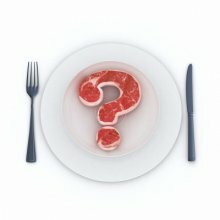Health
Aging vs Spoiling
When you buy beef from a local farmer, the beef is usually dry aged and comes frozen to ensure you are receiving beef of the highest quality. Because most people enjoy the convenience of buying thawed beef at the grocery store, they might not understand why frozen may be better. To fully appreciate the differences, you have to understand how beef is aged, processed and stored prior to purchase. More and more grocery stores have started using a process called gas packing which is designed to make beef appear fresher longer while it sits on their shelves. As Alton Brown would say, this is NOT "good eats".
A River Of Waste
Each year in the United States, 10 billion land animals are raised and killed for meat, eggs, and milk. In factory farms, these sentient animals are intensively confined by the tens if not hundreds of thousands. Confined farm animals produce almost 500 million tons of manure annually, three times more raw waste than generated by Americans (source: Humane Society).
Grocery Store Labeling Tricks
As you walk through your grocery store's meat department, you will come across some very enticing, yet misleading labeling. You might look at a beef label that says "All Natural" and think it sounds pretty good. However, even though the meat is labeled "All Natural", producers can still give their animals Growth Hormones, Antibiotics and raise the animals in crowded feedlots on an unnatural grain-based diet.
Factory Farming - Inside The Meatrix
The Meatrix - Animated Film Series About Factory Farming
Ever heard the term Factory Farming? As defined in Wikipedia, Factory farming is the practice of raising farm animals in confinement at high stocking density, where a farm operates as a factory. The goal of the factory farm is to systematically produce the highest output at the lowest cost. But the hidden costs to human and animal are huge. Read on to learn more about factory farming and watch the award winning animated film series called The Meatrix.
Corn, Cows, Feedlots & Your Health
Almost all the beef found in grocery stores comes from cattle fattened up in large grain feeding operations called feedlots. If you were to visit a ranch and then go to a feedlot, you would immediately notice a couple of striking differences. A cattle feedlot is like an urban city, populated by as many as 100,000 animals. It is crowded, filthy and stinking, with open sewers, unpaved roads and choking air.
Why Grass Fed Beef?
Click Here to listen to a fantastic radio clip from The Beyond Organic Show about Why Grass Fed Beef. This clip features an interview with renouned author, professor and investigative journalist Michael Pollan (author of ).
Health Benefits Of Grass Fed Beef
It has been well documented that products from animals raised on pasture are healthier for humans. From a nutritional standpoint, grass-fed beef is so completely different than grain-fed beef that you might think the meat came from two different types of animals. In fact, 100% grass fed beef is so good for you that it is actually considered a "health food".
More Articles...
- Five Movies that Will Make You a Smarter Meat Eater
- Eggs and Edges
- Organic Valley Launches Organic Milk from 100% GrassFed Cows
- Rating Organic Dairy Brands
- Cows With Names Make More Milk
- Protect Organic From Genetically Engineered Alfalfa
- SLATE Article on E. Coli Incomplete
- Dangers Of Genetically Modified Foods
- Chickens Raised In Battery Cages
- USDA Is Pimping Saturated Fat
Newsflash
|
Grass Fed Beef is high in Omega 3's |







